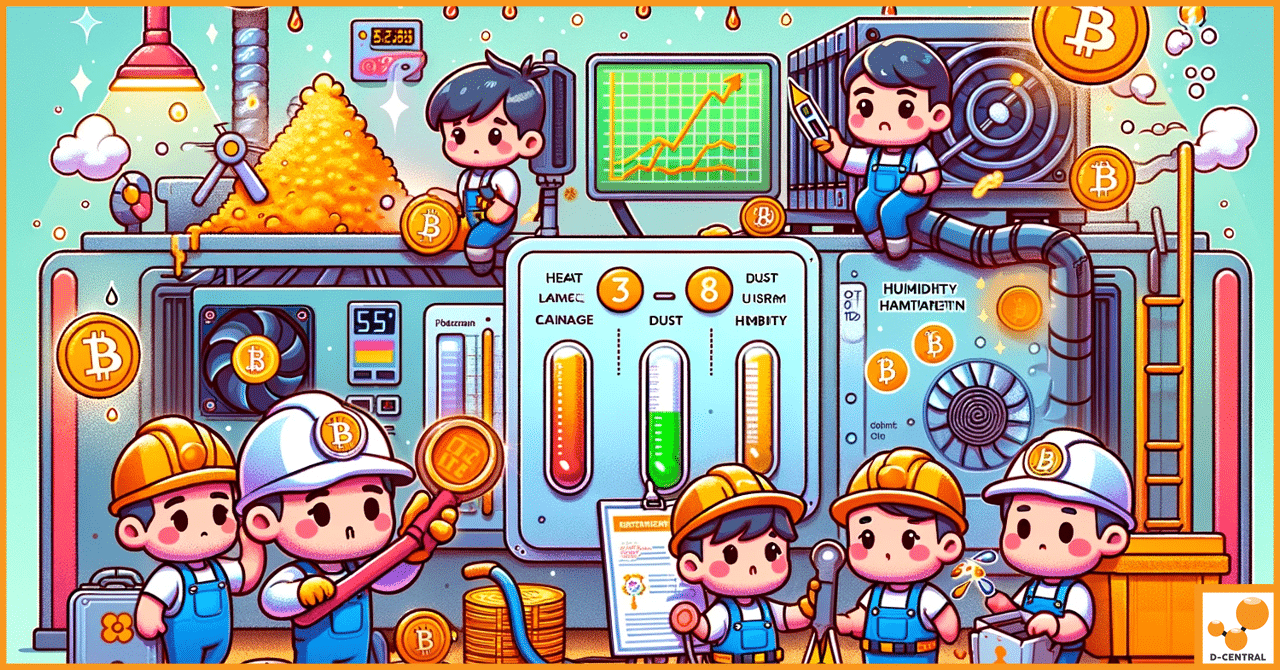
The Truth About Bitcoin Mining: Simple Math on a Cosmic Scale
When one hears about Bitcoin mining, images of supercomputers solving intricate mathematical puzzles often come to mind. This portrayal, frequently
4479 Desserte Nord Autoroute 440, Laval, QC H7P 6E2

In the rapidly evolving world of cryptocurrency mining, the advent of Application-Specific Integrated Circuit (ASIC) miners has marked a significant technological milestone. ASIC miners, designed exclusively for mining cryptocurrencies, have revolutionized the mining process by offering unparalleled efficiency and hashing power. Unlike their predecessors—CPUs (Central Processing Units) and GPUs (Graphics Processing Units)—which are versatile and can perform a wide array of computing tasks, ASIC miners are tailored for a singular purpose: to mine specific cryptocurrencies such as Bitcoin with optimal effectiveness. This specialization has not only escalated the mining arms race but also significantly increased the profitability and scalability of mining operations.
However, as with any high-performance computing hardware, ASIC miners are not immune to wear and tear. The concept of miner deterioration encompasses the gradual decline in efficiency and operational capacity of ASIC miners over time. Factors contributing to this deterioration include continuous intensive operation, environmental conditions such as temperature and humidity, and physical factors like dust accumulation and improper maintenance. The impact of such deterioration is twofold: it not only reduces the hash rate, directly affecting the miner’s profitability by lowering the chances of successfully validating transactions and mining new blocks, but it also increases operational costs due to higher electricity consumption and the need for frequent repairs or replacements.
Understanding the factors that contribute to the deterioration of ASIC miners is crucial for anyone involved in cryptocurrency mining. It enables miners to implement effective strategies to prolong the lifespan of their hardware, optimize mining efficiency, and, ultimately, maximize the profitability of their mining operations. As we delve deeper into the intricacies of ASIC miner maintenance and the challenges posed by hardware deterioration, it becomes evident that proactive measures and regular maintenance are indispensable for sustaining the health and efficiency of mining rigs in the competitive landscape of cryptocurrency mining.
ASIC miners, standing for Application-Specific Integrated Circuit miners, are specialized hardware designed exclusively for cryptocurrency mining. Unlike general-purpose computing devices, ASIC miners are engineered to perform one task with exceptional efficiency: solving the complex cryptographic puzzles required to validate transactions and secure a blockchain network. This singular focus allows ASIC miners to achieve unparalleled hash rates—a measure of mining power—while consuming less energy compared to multi-purpose hardware like CPUs and GPUs.
The journey of cryptocurrency mining hardware has seen a remarkable evolution, mirroring the growth and maturation of the blockchain industry itself. In the early days of Bitcoin, mining was accessible to enthusiasts using the CPUs in their personal computers. As the network grew and the difficulty of mining increased, miners sought more powerful solutions, leading to the adoption of GPUs. Graphics Processing Units, with their ability to handle multiple calculations simultaneously, offered a significant boost in mining efficiency and became the standard for a period.
However, the relentless quest for more efficiency and profitability in mining led to the development of FPGAs (Field-Programmable Gate Arrays), which offered better performance than GPUs but were still not fully optimized for mining. The introduction of ASIC miners represented a quantum leap forward. Built from the ground up to mine cryptocurrencies, ASICs offered exponential increases in hashing power and energy efficiency, fundamentally changing the mining landscape. This shift not only escalated the mining arms race but also raised the barrier to entry, as the cost and complexity of mining with ASIC technology surpassed what casual enthusiasts could reasonably invest.
ASIC miners play a pivotal role in the blockchain ecosystem. Their primary function is to secure the network and process transactions by solving cryptographic puzzles—a process known as proof of work. By doing so, ASIC miners validate transactions and add them to the blockchain, ensuring the integrity and trustworthiness of the network. The specialized efficiency of ASIC miners contributes significantly to the scalability and security of cryptocurrencies, making them indispensable in maintaining the decentralized nature of blockchain networks.
Moreover, ASIC miners contribute to the decentralization of the blockchain by providing a competitive mining environment. While their high cost and operational complexity can be seen as barriers to entry, they also ensure that the network is secured by dedicated and invested participants. This balance between accessibility and investment in the mining process is crucial for the long-term sustainability and security of blockchain networks.
In summary, ASIC miners represent the cutting edge of cryptocurrency mining technology. Their development from CPUs and GPUs reflects the rapid innovation within the blockchain industry, highlighting the continuous search for more efficient and effective ways to secure and validate the ever-growing ledger of transactions that is a blockchain. As the blockchain ecosystem evolves, the role of ASIC miners will undoubtedly continue to be of paramount importance, driving forward the security and efficiency of decentralized digital currencies.
The lifespan of an ASIC miner is significantly influenced by its build quality. High-quality construction not only ensures that the miner can withstand the rigors of continuous operation but also plays a crucial role in maintaining efficiency over time. A well-built ASIC miner, characterized by precision engineering and robust materials, is less prone to the common issues that plague lesser-quality units, such as overheating, component failure, and decreased hashing power. In essence, the build quality directly correlates with the reliability and durability of the miner, impacting its operational lifespan and, by extension, the overall profitability of mining operations.
The choice of components within an ASIC miner is another critical factor that affects its durability and performance. High-grade components, from the ASIC chips themselves to the power supply units and cooling systems, are designed to perform optimally under the intense workload of continuous mining. Quality components can better manage the heat generated during mining, maintain stable operation under varying power conditions, and resist wear and tear, thereby extending the miner’s operational life. Conversely, inferior components may lead to frequent breakdowns, necessitating repairs or replacements that can interrupt mining operations and diminish returns.
Manufacturers that prioritize high-quality components in their ASIC miners typically invest in cutting-edge technology and materials that offer superior performance and longevity. This commitment to quality component selection is a hallmark of reputable manufacturers and is directly reflected in the reliability and efficiency of their mining hardware.
Leading ASIC miner manufacturers recognize the critical importance of build quality and component selection and implement rigorous quality control processes to ensure their products meet the highest standards. Companies like Bitmain, Canaan, and MicroBT, among others, have established themselves as industry leaders partly due to their commitment to manufacturing excellence.
These manufacturers’ insights into quality control highlight a shared understanding of the critical role that build quality and component selection play in the success of ASIC mining operations. By adhering to high manufacturing standards, they not only provide miners with reliable and efficient hardware but also contribute to the advancement of the cryptocurrency mining industry as a whole. The emphasis on quality ensures that miners can maximize their investment, achieving better longevity and profitability from their ASIC mining hardware.
The environment in which ASIC miners operate plays a crucial role in their efficiency, durability, and overall lifespan. Factors such as temperature, humidity, and airflow significantly impact the performance and operational health of these specialized mining devices. Understanding and managing these environmental factors are essential for maintaining optimal mining conditions and prolonging the life of ASIC hardware.
The Effects of High Operating Temperatures on ASIC Hardware
High operating temperatures are among the most significant challenges facing ASIC miners. These devices generate a substantial amount of heat due to the intense computational work they perform. Prolonged exposure to high temperatures can lead to thermal stress on the ASIC chips and other critical components, accelerating wear and tear, reducing efficiency, and increasing the risk of hardware failure. Overheating can also cause solder joints to weaken or break, leading to intermittent connections or complete loss of functionality.
Optimal Temperature Ranges for ASIC Operation
To ensure the longevity and reliability of ASIC miners, it is crucial to maintain them within optimal temperature ranges. Generally, the recommended operating temperature for most ASIC mining equipment lies between 20°C to 30°C (68°F to 86°F). Operating within this range helps in minimizing the risk of thermal damage and maximizes the efficiency of the mining process. Implementing cooling solutions and monitoring temperature levels can aid in maintaining these optimal conditions.
The Risks of Operating in High Humidity Environments
High humidity levels pose a significant risk to ASIC miners, primarily through the potential for moisture accumulation within the hardware. Moisture can lead to corrosion of metal components and electrical shorts, significantly impacting the miner’s performance and potentially leading to irreversible damage. Furthermore, environments with fluctuating humidity levels can exacerbate these risks, as condensation is more likely to occur when warm, humid air comes into contact with cooler surfaces of the mining equipment.
Preventative Measures to Protect Against Moisture-Induced Damage
To safeguard ASIC miners from the detrimental effects of high humidity and moisture, several preventative measures can be implemented:
The Importance of Proper Ventilation in Mining Setups
Adequate ventilation is essential for dissipating the heat generated by ASIC miners and preventing the buildup of hot air within the mining environment. Without proper ventilation, miners are at risk of overheating, which can lead to reduced efficiency, increased power consumption, and heightened risk of hardware failure. Effective ventilation systems ensure a constant flow of air that helps in maintaining optimal operating temperatures and improving the overall stability of mining operations.
Strategies for Ensuring Adequate Airflow Around ASIC Miners
Implementing strategies to enhance airflow and ventilation within mining setups can significantly impact the health and performance of ASIC miners:
By addressing these environmental factors and implementing measures to control temperature, humidity, and airflow, miners can significantly improve the operational efficiency and lifespan of their ASIC mining hardware. These practices not only contribute to the sustainability of mining operations but also enhance profitability by reducing downtime and maintenance costs.
The relentless demand for cryptocurrency mining has led to ASIC miners being pushed to their operational limits. While designed for continuous use, the intense and unrelenting nature of mining operations subjects these devices to significant stress, impacting their longevity and performance. Understanding the operational stressors, including continuous operation and overclocking, is crucial for maintaining the health and efficiency of ASIC miners.
The Impact of 24/7 Mining Operations on Hardware Longevity
ASIC miners are typically run 24/7 to maximize mining profits. This non-stop operation can significantly strain the hardware, leading to accelerated wear and tear. Continuous operation without adequate cooling and maintenance can result in overheating, which not only reduces the efficiency of the miners but also shortens their lifespan. The thermal stress affects not just the ASIC chips but also other critical components such as the power supply units and cooling fans, increasing the likelihood of failure.
Balancing Performance with Maintenance to Extend Lifespan
To mitigate the effects of continuous operation, a balanced approach to performance and maintenance is essential. Implementing a regular maintenance schedule can help identify and address potential issues before they lead to significant damage. This includes cleaning dust from the miners, checking and replacing worn-out components, and ensuring the cooling systems are functioning optimally. Additionally, allowing for periodic downtime, when feasible, can help reduce the thermal load on the hardware, contributing to a longer operational life.
The Potential Benefits and Risks of Overclocking ASIC Miners
Overclocking involves configuring ASIC miners to operate beyond their default speed settings to increase their hash rate and, potentially, the mining rewards. While overclocking can offer a competitive edge in the mining process by boosting performance, it comes with significant risks. The increased operational intensity elevates power consumption and heat production, putting additional stress on the hardware. This can lead to more frequent breakdowns, higher electricity costs, and a reduced lifespan for the miner.
How Overclocking Can Accelerate Deterioration
The accelerated deterioration due to overclocking is primarily a result of the excessive heat generated by pushing the miners beyond their designed capacity. The additional thermal stress can degrade the ASIC chips and other components more quickly, leading to a higher failure rate. Moreover, the increased power consumption can strain the power supply unit, potentially leading to instability or damage. Overclocking without careful monitoring and adequate cooling measures can therefore significantly diminish the efficiency and longevity of ASIC miners.
In conclusion, while the operational demands of cryptocurrency mining necessitate pushing ASIC miners to their limits, understanding and managing the associated stressors are vital for sustaining their performance and lifespan. A proactive approach to maintenance, coupled with a judicious use of overclocking, can help miners navigate the challenges of continuous operation, ensuring their mining endeavors remain profitable over the long term.
Proper maintenance is crucial for maximizing the lifespan and efficiency of ASIC miners. Regular upkeep not only helps in preventing premature deterioration but also ensures that the mining hardware operates at optimal efficiency. Understanding and implementing effective maintenance practices can significantly extend the operational life of ASIC miners, thereby enhancing the profitability of mining operations.
Routine maintenance tasks are essential for keeping ASIC miners in good working condition. These tasks include:
The importance of these routine maintenance tasks cannot be overstated. They help in identifying potential issues before they escalate into major problems, reduce downtime due to hardware failure, and maintain the mining efficiency of the ASIC miners.
Dust accumulation is one of the primary environmental factors that can degrade the performance and lifespan of ASIC miners. Effective dust management strategies include:
Implementing these dust management strategies can significantly reduce the risk of overheating and component failure, thereby extending the operational life of the ASIC miners.
Firmware updates play a critical role in maintaining the efficiency and security of ASIC miners. Manufacturers often release firmware updates to:
Staying current with firmware updates ensures that ASIC miners operate with the latest improvements and protections offered by the manufacturer. Regularly checking the manufacturer’s website or subscribing to update notifications can help miners keep their firmware up to date.
In summary, adopting a comprehensive maintenance regimen that includes routine checks, effective dust management, and timely firmware updates is essential for prolonging the lifespan and enhancing the efficiency of ASIC miners. These practices not only safeguard the hardware investment but also ensure sustained profitability in the competitive field of cryptocurrency mining.
Throughout this exploration of the factors contributing to ASIC miner deterioration, we’ve delved into the critical aspects that influence the longevity and efficiency of these specialized mining devices. From the inherent challenges posed by the manufacturing quality and environmental conditions to the operational stressors of continuous use and overclocking, it’s clear that maintaining ASIC miners requires a comprehensive understanding and proactive approach.
The key to maximizing the lifespan and profitability of ASIC mining operations lies in balancing efficiency, maintenance, and sustainability. High-quality manufacturing and careful component selection lay the foundation for durable and reliable mining hardware. However, the operational environment—characterized by optimal temperature, humidity, and airflow—plays an equally vital role in preserving the hardware’s integrity and performance. Moreover, the intensity of use, particularly practices like overclocking, must be managed judiciously to prevent accelerated wear and tear.
Routine maintenance, including regular cleaning, dust management, and firmware updates, emerges as an indispensable strategy for combating deterioration. These practices not only extend the operational life of ASIC miners but also ensure they run at peak efficiency, thereby safeguarding the investment and maximizing returns.
As we conclude, we encourage all members of the mining community to adopt these best practices in ASIC miner maintenance. By doing so, you contribute not only to the longevity of your mining hardware but also to the sustainability and advancement of the broader cryptocurrency mining ecosystem. The collective effort to maintain and optimize mining operations can lead to more efficient, profitable, and environmentally responsible mining practices.
We invite you to share your experiences, insights, and feedback on ASIC miner maintenance. Whether you’ve discovered innovative solutions to common challenges or have questions about optimizing your mining setup, your contributions can enrich the knowledge base of the mining community. Together, we can navigate the complexities of cryptocurrency mining and continue to thrive in this dynamic and evolving industry.
What are ASIC miners?
ASIC miners are specialized hardware designed exclusively for cryptocurrency mining. Tailored to perform the complex cryptographic puzzles required in the mining process, they offer unmatched efficiency and hashing power for mining specific cryptocurrencies like Bitcoin.
How do ASIC miners differ from CPUs and GPUs?
ASIC miners are designed for a singular purpose – cryptocurrency mining, making them more efficient than CPUs and GPUs, which are general-purpose computing devices capable of performing a wide array of tasks but with less efficiency in mining.
What factors contribute to the deterioration of ASIC miners?
The deterioration of ASIC miners is primarily due to the continuous intensive operation, environmental conditions like temperature and humidity, and physical factors such as dust accumulation and improper maintenance, all of which reduce efficiency and lifespan.
How does the manufacturing quality affect the lifespan of ASIC miners?
The build quality of ASIC miners significantly influences their lifespan. High-quality construction, characterized by precision engineering and robust materials, ensures durability and reliability, making miners less prone to issues like overheating and component failure.
What environmental factors affect ASIC miners?
Temperature, humidity, and airflow are crucial environmental factors that impact ASIC miners. Optimal environmental conditions prevent overheating, moisture-induced damage, and ensure sufficient heat dissipation, which are essential for the efficiency and longevity of ASIC miners.
What are the consequences of continuous operation and overclocking on ASIC miners?
Continuous operation and overclocking put considerable stress on ASIC miners, leading to accelerated wear and tear. Continuous operation without adequate cooling can cause overheating, while overclocking increases thermal load and power consumption, potentially reducing the miners’ lifespan.
What maintenance practices can prolong the lifespan of ASIC miners?
Effective maintenance practices include routine checks and cleaning, effective dust management, and timely firmware updates. These practices help in preventing premature deterioration, identifying potential issues early on, and keeping the miners running at peak efficiency.
How can miners optimize the operation to prolong the life of ASIC miners?
Miners can optimize operations by maintaining their hardware within optimal environmental conditions, balancing the demands of continuous mining with regular maintenance, and managing the risks associated with overclocking carefully to prevent unnecessary stress on the miners.
DISCLAIMER: D-Central Technologies and its associated content, including this blog, do not serve as financial advisors or official investment advisors. The insights and opinions shared here or by any guests featured in our content are provided purely for informational and educational purposes. Such communications should not be interpreted as financial, investment, legal, tax, or any form of specific advice. We are committed to advancing the knowledge and understanding of Bitcoin and its potential impact on society. However, we urge our community to proceed with caution and informed judgment in all related endeavors.
Related Posts

When one hears about Bitcoin mining, images of supercomputers solving intricate mathematical puzzles often come to mind. This portrayal, frequently

In recent years, the energy sector in the U.S. has been under scrutiny, not just for its contribution to global

In the ever-evolving landscape of digital finance, Bitcoin has emerged as a frontrunner, captivating the attention of investors, technologists, and